A Day on the Farm
I quickly realized the enormity of the task at hand: to capture a typical day on the family farm
through photo-journalism. How could I possibly do that when I had just spent months learning
about the incredible diversity within farming? I knew that there was no such thing as a "typical day."
Things vary so greatly according to the type of farm, the season,
the size, the day of the week,
and countless other things. Knowing that even if I studied one hundred farms, I still would not
be able to graph a "typical day," I resolved my dilemma by visiting one farm on one day. I
hoped that this would serve as a mere example of what a day on a farm might entail.
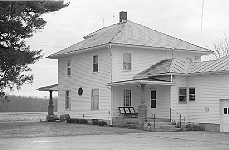 I chose to visit Dennis and Becky Shinaberry's sheep and cattle farm in Fredericktown. Becky
and I spoke and decided that a Saturday would be the best day. My day on the farm actually
began the night before, as I knew that I would have great difficulty rising early enough to make it
to the Shinaberrys in time to start their day with them. Late Friday night, I packed some "get
dirty" clothes and awaited Becky's arrival. She whisked me off into the soft country hills where
her family farm lies. We arrived home to find all but Dennis asleep-- I soon followed the
majority, drifting off with thoughts of what my experience might be like the next day.
I chose to visit Dennis and Becky Shinaberry's sheep and cattle farm in Fredericktown. Becky
and I spoke and decided that a Saturday would be the best day. My day on the farm actually
began the night before, as I knew that I would have great difficulty rising early enough to make it
to the Shinaberrys in time to start their day with them. Late Friday night, I packed some "get
dirty" clothes and awaited Becky's arrival. She whisked me off into the soft country hills where
her family farm lies. We arrived home to find all but Dennis asleep-- I soon followed the
majority, drifting off with thoughts of what my experience might be like the next day.
Becky roused me at 7:15 am. I eventually stumbled downstairs to the kitchen and found Becky
trimming Dennis' hair. In the living room next door I found the t.v. on with Joshua and Jeremy,
two of three sons, intently watching Saturday morning cartoons. Jim, the youngest, was the last
to come down. After some hefty persuasion, Becky and Dennis were able to convince the boys
to tear themselves away from the t.v. to meet me and eat some breakfast. This seemed to
be the typical family scene on a Saturday morning. The boys appeared excited and confused
upon learning that I would be taking photos of them doing daily tasks on the farm. My presence,
however, was not enough to lure them away from the t.v. when breakfast was over and to come
along with Dennis and me on our first chore of the day.
Dennis and I headed out to the shed that houses about half of the Shinaberry's sheep-- the
mothers and their newly born lambs. Dennis filled their water basin. He pulled down bales of
hay from the storage above for the grown sheep.  He also fed them a ground meal substance
consisting of mostly corn and other nutrients they need, as they were still nursing the young
lambs.
He also fed them a ground meal substance
consisting of mostly corn and other nutrients they need, as they were still nursing the young
lambs.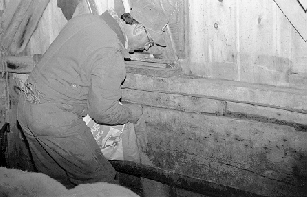 The lambs received their own specialized food placed in an isolated pen.
The lambs received their own specialized food placed in an isolated pen.
Once the sheep were happily munching, we hopped into Dennis' pick-up truck and traveled
about a quarter of a mile down the road to get a tractor from the cattle farm of his father and
mother, Doc and June. 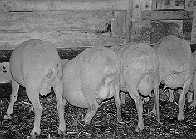 On the way over, I learned that Dennis spends a good deal of his time
working his parents' farm as well as his own. The two farms seem to be almost inseparable. In
return, Doc and June help out at Dennis and Becky's farm whenever they can.
On the way over, I learned that Dennis spends a good deal of his time
working his parents' farm as well as his own. The two farms seem to be almost inseparable. In
return, Doc and June help out at Dennis and Becky's farm whenever they can.
I quickly checked out Doc and June's cattle and then climbed on the tractor for the slow, but
exhilarating ride back to the Shinaberry farm.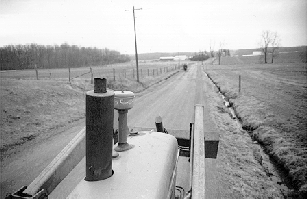 As we drove back I could see that Becky had
gotten the boys out of the house for I could see them staging an ambush for Dennis and me in the ditch by the
side of the road. They were now ready to help out with the chores for the day. The next task
involved filling up a large wagon with straw bales to be used as bedding for the sheep and lambs.
As we drove back I could see that Becky had
gotten the boys out of the house for I could see them staging an ambush for Dennis and me in the ditch by the
side of the road. They were now ready to help out with the chores for the day. The next task
involved filling up a large wagon with straw bales to be used as bedding for the sheep and lambs.
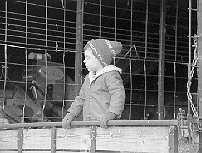 Dennis backed the tractor up to the back storage end of the sheep and lamb shed where the
wagon rested almost empty. After some struggle he, Josh and Michael (Josh's friend visiting for
the day) managed to get the tractor hitched to the wagon. Dennis parked across the yard, just
below the second floor window of the barn. Becky, Josh, Jeremy, Jim, Michael and I clambered
up the ladders to the second story of the bale-filled barn. We spent a great deal of time tossing
bales of straw out the window as Dennis stood in the wagon below and stacked them up. I
quickly learned how exhausting this work is, for the bales most definitely did not tip the light
end of the scale. The hard effort did have its rewards, for when we finished, the boys took turns swinging from a
rope dangling from the rafters.
Dennis backed the tractor up to the back storage end of the sheep and lamb shed where the
wagon rested almost empty. After some struggle he, Josh and Michael (Josh's friend visiting for
the day) managed to get the tractor hitched to the wagon. Dennis parked across the yard, just
below the second floor window of the barn. Becky, Josh, Jeremy, Jim, Michael and I clambered
up the ladders to the second story of the bale-filled barn. We spent a great deal of time tossing
bales of straw out the window as Dennis stood in the wagon below and stacked them up. I
quickly learned how exhausting this work is, for the bales most definitely did not tip the light
end of the scale. The hard effort did have its rewards, for when we finished, the boys took turns swinging from a
rope dangling from the rafters.
When Becky and I got out of the barn, we found Dennis repairing a wood panel on the second story barn window.
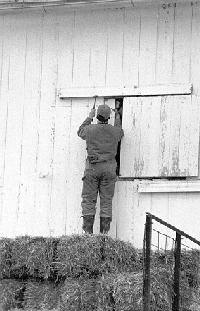 He and Becky then proceeded to fix a flat tire on the wagon- Jim watching enthusiastically.
The wagon was then replaced in the shed. Dennis drove the tractor back to his parents' house with Josh, Michael and Jeremy.
While there, they cleaned out the clogged drainage tile of the
crick that runs through his parents' property.
He and Becky then proceeded to fix a flat tire on the wagon- Jim watching enthusiastically.
The wagon was then replaced in the shed. Dennis drove the tractor back to his parents' house with Josh, Michael and Jeremy.
While there, they cleaned out the clogged drainage tile of the
crick that runs through his parents' property.
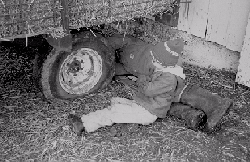
Becky, Jim and I returned to the house. Becky and I talked while she prepared lunch. I had questions about
the ways in which her sons deal with the animals they raise-- knowing that they are raised for
slaughter. Becky responded saying that that was a lot of what growing up on a farm was all
about-- learning that what they do is their occupation: "I guess they've understood from day one, this is what
Dennis does for a living. . . . We do it because we want to be able to put food on the table, and we want to be able
to buy toys for the kids, and go places and do things. . . . The kids understand that they're [the sheep] there to play
with, but in order for us to live, this is Daddy's business. So as far as the kids go, . . . it's the same way with us--
we were raised that way." -Becky Shinaberry
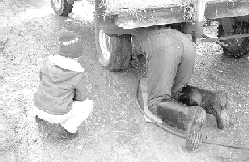
Dennis, Josh, Michael and Jeremy soon returned and we all sat down to lunch. Just as we were finishing, the Shinaberry's
neighbor, Art Noble, arrived. Dennis informed me that he had come to help out with de-tailing
and castrating of the lambs. Doc, too, was expected to assist with the main task of the day. Before
his arrival, however, conversation concerning land and zoning laws ensued. Because much of
our class discussions revolved around issues of farm land sold to developers, I wanted to know
what farmers themselves think about it. While they certainly seemed to lament that much of farm
land is now turned into subdivisions and strip malls, they could, at the same time, understand
why a farmer might be forced to sell to developers for a good price. In fact, that is exactly what
Mr. Noble had to do. He said that it was one of the hardest decisions he ever had to make.
"Back in the sixties and seventies, farmland was being bought by farmers. . . . Now, there is no farms being bought
by farmers. . . . Why would he [a farmer] want to sell it [the farmland] to another farmer for a 1,000 dollars an acre when
a developer is going to give him three?" -Dennis Shinaberry
One of the most detrimental consequences of these sprouting subdivisions seems to be the lack of
communication between farmers and their new neighbors. Often times, the newcomers do not
fully understand the runnings of a farm. It might be frustrating to have to slow down behind the
tractors on the road or to have to deal with the foreign and sometimes unpleasant smells that a
farm will inevitably produce. Farmers, too, have their grievances, such as finding curious
people trespassing on their land in search of arrowheads, and having to clean up excessive litter.
There is a definite cry for mutual understanding here.
Conversation had to come to a close and we headed out to the lamb shed. As if reading my
mind, Dennis began to explain the processes of and reasons for de-tailing and castrating. I
learned that lambs are de-tailed for health reasons. If lambs retain their tails, fecal matter has the
tendency to build up on the wool around the rear end. This is highly conducive to infection as
flies are tempted to lay their eggs there. The castration is necessary for selective breeding.
Farmers generally choose the best of their animals for breeding. Besides, it would be a bit of a
mad house if they did not castrate some of the flock.
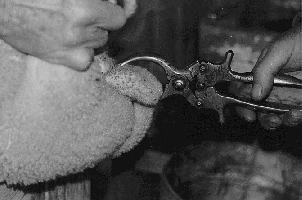 Next Dennis clamped the tail high up near the lamb's rear. With a swift movement, he cut the tail.
I asked Dennis if this hurt the lambs. He said that because the tail is only cartilage, the pain is
comparable to getting ones' ears pierced. The younger the lambs are, the less pain they will
experience. All the lambs de-tailed that day were anywhere between three weeks and three
months old.
Next Dennis clamped the tail high up near the lamb's rear. With a swift movement, he cut the tail.
I asked Dennis if this hurt the lambs. He said that because the tail is only cartilage, the pain is
comparable to getting ones' ears pierced. The younger the lambs are, the less pain they will
experience. All the lambs de-tailed that day were anywhere between three weeks and three
months old.
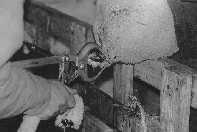 The next step was spraying the fresh wound. Dennis told me that the spray quickened the
clotting of the blood and also kept the area infection-free. Mr. Noble then set the lamb
down on the opposite side of the fence, allowing it to seek out its mother.
The next step was spraying the fresh wound. Dennis told me that the spray quickened the
clotting of the blood and also kept the area infection-free. Mr. Noble then set the lamb
down on the opposite side of the fence, allowing it to seek out its mother.
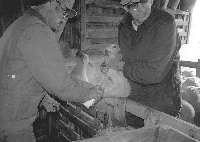 Michael's father, a hog farmer, joined in for a while to help out and experience something new.
He held the lambs on the fence, giving Mr. Noble a break. It was interesting to witness this
comraderie and cooperation among farmers. For me, it solidified the idea of farmers working
together, always willing to help one another out.
Michael's father, a hog farmer, joined in for a while to help out and experience something new.
He held the lambs on the fence, giving Mr. Noble a break. It was interesting to witness this
comraderie and cooperation among farmers. For me, it solidified the idea of farmers working
together, always willing to help one another out.
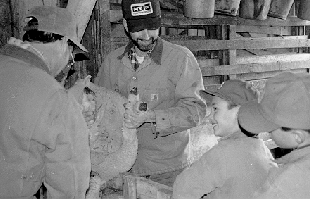 This process took up the majority of the afternoon, as there were nearly fifty lambs. Mr. Noble
would know the exact number, for he counted the tails when we were done! (I made him lose
count when he realized that I was photographing him and had to start over.)
This process took up the majority of the afternoon, as there were nearly fifty lambs. Mr. Noble
would know the exact number, for he counted the tails when we were done! (I made him lose
count when he realized that I was photographing him and had to start over.)
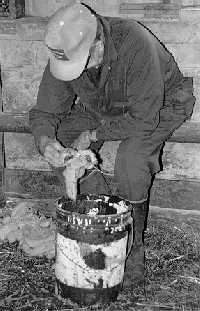 Becky, the boys and I walked back to the house. After the work was done, Doc and Mr. Noble went on their
respective ways; Doc on his tractor, of course. Dennis and Michael's father stayed out
a while, chatting.
Becky, the boys and I walked back to the house. After the work was done, Doc and Mr. Noble went on their
respective ways; Doc on his tractor, of course. Dennis and Michael's father stayed out
a while, chatting.
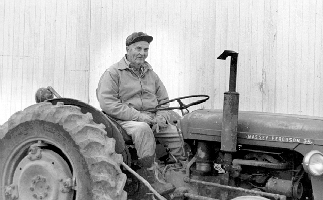 I relaxed with the boys and watched about half of The Mighty Ducks until
Dennis came in and told me that there was one more chore to do. Although none of the boys
wanted to go along, I faithfully grabbed my camera and headed outside with him. We went back
into the shed to give the sheep and lambs one more meal. We then proceeded to the big barn to
feed the second half of the Shinaberry's sheep. Because these sheep were grown, and those that
were female were not pregnant, they received a simple meal of just hay.
I relaxed with the boys and watched about half of The Mighty Ducks until
Dennis came in and told me that there was one more chore to do. Although none of the boys
wanted to go along, I faithfully grabbed my camera and headed outside with him. We went back
into the shed to give the sheep and lambs one more meal. We then proceeded to the big barn to
feed the second half of the Shinaberry's sheep. Because these sheep were grown, and those that
were female were not pregnant, they received a simple meal of just hay.
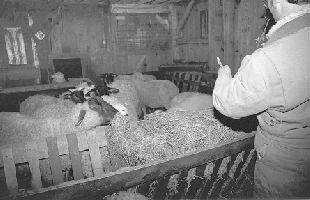 They, too, have a water basin that
Dennis filled. One finicky sheep, who rarely drinks from the basin, took her drink from the
water spout.
They, too, have a water basin that
Dennis filled. One finicky sheep, who rarely drinks from the basin, took her drink from the
water spout.
Next on the agenda was feeding the cattle, which are housed in the rear section of the barn.
Dennis and I climbed up into the silo adjoining the barn that houses the cows' food: silage,
which is ground corn, stalk and all. Standing in the silo with a floor of silage one story high was
a strange experience. I felt rather claustrophobic as a wall of circular cement surrounded me and
the silage smelled fermented and strangely sweet. However, when I looked up and saw the sky I felt
calmed.
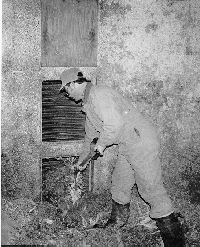 Dennis began hurling loads of silage with a pitchfork down to a trough below. The trough had a
silage auger that cut up the silage a bit more and also moves it down
along the length of the trough so that all the cows have access to the food.
Dennis began hurling loads of silage with a pitchfork down to a trough below. The trough had a
silage auger that cut up the silage a bit more and also moves it down
along the length of the trough so that all the cows have access to the food.
Once enough silage was thrown down, Dennis and I ascended the ladder. I watched the cows
watching me for a while- they seemed suspicious of my presence.
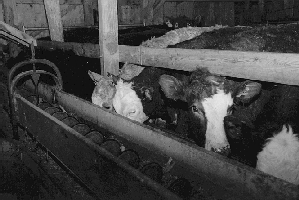 We were finally done! It was about six o'clock and I was incredibly tired. I could not imagine what other
seasons on the farm were
like since Dennis told me that our day was somewhat short as the winter is a bit slow for them.
We retreated to the house and I told Becky that I thought I had finally completed my day on the
farm. I gave many thanks to the family for their help, explanations, patience and photographs. I
promised lots of pictures once I had developed the film. I gathered my belongings and went out
to the car with Becky and Josh, whom Becky asked to come along for the ride.
We were finally done! It was about six o'clock and I was incredibly tired. I could not imagine what other
seasons on the farm were
like since Dennis told me that our day was somewhat short as the winter is a bit slow for them.
We retreated to the house and I told Becky that I thought I had finally completed my day on the
farm. I gave many thanks to the family for their help, explanations, patience and photographs. I
promised lots of pictures once I had developed the film. I gathered my belongings and went out
to the car with Becky and Josh, whom Becky asked to come along for the ride.
On the way home, I reflected upon my day. I had witnessed some pretty spectacular things. The
Shinaberry family truly operated together as a family. The individual roles were dynamic and
that seemed to allow things to flow so smoothly. I was impressed with all the talents and
knowledge necessary to operate a farm. I had seen Dennis be a father, farmer, veteranarian, carpenter and mechanic. I had
seen Becky be a mother, farmer, cook and mechanic. Most importantly, I had seen the
Shinaberrys be a family that worked with dedication and cooperation. That seemed to be the
key.
I had learned so much that day. I felt that I could better appreciate what living on a farm is
like. I now have a more acurate idea of how full a day on the farm is. The crucial part, however,
is that I can share my knowledge.
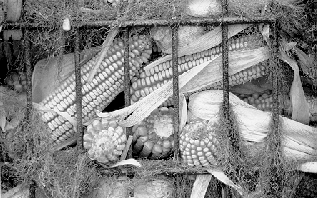 To see more photographs of my day on the farm
click here.
To see more photographs of my day on the farm
click here.
photo credits: Mitra Fabian


 E-Mail The Family Farm Project
E-Mail The Family Farm Project
 I chose to visit Dennis and Becky Shinaberry's sheep and cattle farm in Fredericktown. Becky
and I spoke and decided that a Saturday would be the best day. My day on the farm actually
began the night before, as I knew that I would have great difficulty rising early enough to make it
to the Shinaberrys in time to start their day with them. Late Friday night, I packed some "get
dirty" clothes and awaited Becky's arrival. She whisked me off into the soft country hills where
her family farm lies. We arrived home to find all but Dennis asleep-- I soon followed the
majority, drifting off with thoughts of what my experience might be like the next day.
I chose to visit Dennis and Becky Shinaberry's sheep and cattle farm in Fredericktown. Becky
and I spoke and decided that a Saturday would be the best day. My day on the farm actually
began the night before, as I knew that I would have great difficulty rising early enough to make it
to the Shinaberrys in time to start their day with them. Late Friday night, I packed some "get
dirty" clothes and awaited Becky's arrival. She whisked me off into the soft country hills where
her family farm lies. We arrived home to find all but Dennis asleep-- I soon followed the
majority, drifting off with thoughts of what my experience might be like the next day. He also fed them a ground meal substance
consisting of mostly corn and other nutrients they need, as they were still nursing the young
lambs.
He also fed them a ground meal substance
consisting of mostly corn and other nutrients they need, as they were still nursing the young
lambs. The lambs received their own specialized food placed in an isolated pen.
The lambs received their own specialized food placed in an isolated pen. On the way over, I learned that Dennis spends a good deal of his time
working his parents' farm as well as his own. The two farms seem to be almost inseparable. In
return, Doc and June help out at Dennis and Becky's farm whenever they can.
On the way over, I learned that Dennis spends a good deal of his time
working his parents' farm as well as his own. The two farms seem to be almost inseparable. In
return, Doc and June help out at Dennis and Becky's farm whenever they can. As we drove back I could see that Becky had
gotten the boys out of the house for I could see them staging an ambush for Dennis and me in the ditch by the
side of the road. They were now ready to help out with the chores for the day. The next task
involved filling up a large wagon with straw bales to be used as bedding for the sheep and lambs.
As we drove back I could see that Becky had
gotten the boys out of the house for I could see them staging an ambush for Dennis and me in the ditch by the
side of the road. They were now ready to help out with the chores for the day. The next task
involved filling up a large wagon with straw bales to be used as bedding for the sheep and lambs. Dennis backed the tractor up to the back storage end of the sheep and lamb shed where the
wagon rested almost empty. After some struggle he, Josh and Michael (Josh's friend visiting for
the day) managed to get the tractor hitched to the wagon. Dennis parked across the yard, just
below the second floor window of the barn. Becky, Josh, Jeremy, Jim, Michael and I clambered
up the ladders to the second story of the bale-filled barn. We spent a great deal of time tossing
bales of straw out the window as Dennis stood in the wagon below and stacked them up. I
quickly learned how
Dennis backed the tractor up to the back storage end of the sheep and lamb shed where the
wagon rested almost empty. After some struggle he, Josh and Michael (Josh's friend visiting for
the day) managed to get the tractor hitched to the wagon. Dennis parked across the yard, just
below the second floor window of the barn. Becky, Josh, Jeremy, Jim, Michael and I clambered
up the ladders to the second story of the bale-filled barn. We spent a great deal of time tossing
bales of straw out the window as Dennis stood in the wagon below and stacked them up. I
quickly learned how  He and Becky then proceeded to fix a flat tire on the wagon- Jim watching enthusiastically.
The wagon was then replaced in the shed. Dennis drove the tractor back to his parents' house with Josh, Michael and Jeremy.
While there, they cleaned out the clogged drainage tile of the
crick that runs through his parents' property.
He and Becky then proceeded to fix a flat tire on the wagon- Jim watching enthusiastically.
The wagon was then replaced in the shed. Dennis drove the tractor back to his parents' house with Josh, Michael and Jeremy.
While there, they cleaned out the clogged drainage tile of the
crick that runs through his parents' property. 

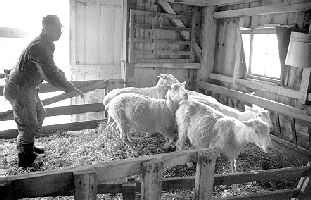
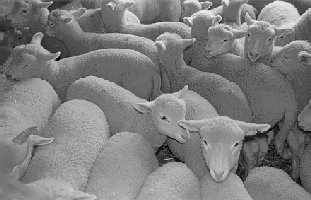
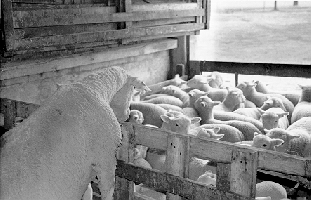
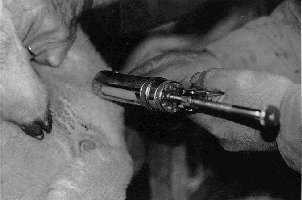
 Next Dennis clamped the tail high up near the lamb's rear. With a swift movement, he cut the tail.
I asked Dennis if this hurt the lambs. He said that because the tail is only cartilage, the pain is
comparable to getting ones' ears pierced. The younger the lambs are, the less pain they will
experience. All the lambs de-tailed that day were anywhere between three weeks and three
months old.
Next Dennis clamped the tail high up near the lamb's rear. With a swift movement, he cut the tail.
I asked Dennis if this hurt the lambs. He said that because the tail is only cartilage, the pain is
comparable to getting ones' ears pierced. The younger the lambs are, the less pain they will
experience. All the lambs de-tailed that day were anywhere between three weeks and three
months old. The next step was spraying the fresh wound. Dennis told me that the spray quickened the
clotting of the blood and also kept the area infection-free. Mr. Noble then set the lamb
down on the opposite side of the fence, allowing it to seek out its mother.
The next step was spraying the fresh wound. Dennis told me that the spray quickened the
clotting of the blood and also kept the area infection-free. Mr. Noble then set the lamb
down on the opposite side of the fence, allowing it to seek out its mother. Michael's father, a hog farmer, joined in for a while to help out and experience something new.
He held the lambs on the fence, giving Mr. Noble a break. It was interesting to witness this
comraderie and cooperation among farmers. For me, it solidified the idea of farmers working
together, always willing to help one another out.
Michael's father, a hog farmer, joined in for a while to help out and experience something new.
He held the lambs on the fence, giving Mr. Noble a break. It was interesting to witness this
comraderie and cooperation among farmers. For me, it solidified the idea of farmers working
together, always willing to help one another out. This process took up the majority of the afternoon, as there were nearly fifty lambs. Mr. Noble
would know the exact number, for he counted the tails when we were done! (I made him lose
count when he realized that I was photographing him and had to start over.)
This process took up the majority of the afternoon, as there were nearly fifty lambs. Mr. Noble
would know the exact number, for he counted the tails when we were done! (I made him lose
count when he realized that I was photographing him and had to start over.) Becky, the boys and I walked back to the house. After the work was done, Doc and Mr. Noble went on their
respective ways; Doc on his tractor, of course. Dennis and Michael's father stayed out
a while, chatting.
Becky, the boys and I walked back to the house. After the work was done, Doc and Mr. Noble went on their
respective ways; Doc on his tractor, of course. Dennis and Michael's father stayed out
a while, chatting. I relaxed with the boys and watched about half of The Mighty Ducks until
Dennis came in and told me that there was one more chore to do. Although none of the boys
wanted to go along, I faithfully grabbed my camera and headed outside with him. We went back
into the shed to give the sheep and lambs one more meal. We then proceeded to the big barn to
feed the second half of the Shinaberry's sheep. Because these sheep were grown, and those that
were female were not pregnant, they received a simple meal of just hay.
I relaxed with the boys and watched about half of The Mighty Ducks until
Dennis came in and told me that there was one more chore to do. Although none of the boys
wanted to go along, I faithfully grabbed my camera and headed outside with him. We went back
into the shed to give the sheep and lambs one more meal. We then proceeded to the big barn to
feed the second half of the Shinaberry's sheep. Because these sheep were grown, and those that
were female were not pregnant, they received a simple meal of just hay.
 They, too, have a water basin that
Dennis filled. One finicky sheep, who rarely drinks from the basin, took her drink from the
water spout.
They, too, have a water basin that
Dennis filled. One finicky sheep, who rarely drinks from the basin, took her drink from the
water spout. Dennis began hurling loads of silage with a pitchfork down to a trough below. The trough had a
silage auger that cut up the silage a bit more and also moves it down
along the length of the trough so that all the cows have access to the food.
Dennis began hurling loads of silage with a pitchfork down to a trough below. The trough had a
silage auger that cut up the silage a bit more and also moves it down
along the length of the trough so that all the cows have access to the food. We were finally done! It was about six o'clock and I was incredibly tired. I could not imagine what other
We were finally done! It was about six o'clock and I was incredibly tired. I could not imagine what other
 To see more photographs of my day on the farm
click
To see more photographs of my day on the farm
click 

 E-Mail The Family Farm Project
E-Mail The Family Farm Project